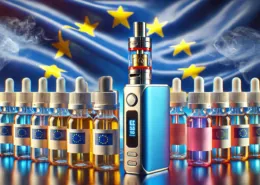Denmark Plans Severe Restrictions on Nicotine Pouches
Denmark has notified the European Commission of its intention to impose strict limitations on nicotine pouches, following a position paper presented at the Employment, Social Policy, Health and Consumer Affairs Council on June 21. Unlike the blanket bans put in place or proposed in the Benelux countries, Denmark’s rules will ban most flavors and any product with a nicotine content above 9 mg per pouch.
The proposed nicotine cap at 9 mg per pouch is less than half the amount allowed in most countries with caps in place and would remove approximately half of the products sold on the European market. Products with 6-12 mg of nicotine per pouch, the most popular strength, represented 40% of sales in 2023, while products with higher than 12 mg of nicotine per pouch accounted for 28%.
NNPA Supports Nicotine Cap but Warns Against Setting It Too Low
The NNPA (New Nicotine Products Association) supports the idea of a nicotine cap to restrict extreme products on the market due to their very high nicotine content. However, the organization strongly believes that setting a too low nicotine cap is a mistake and counterproductive. As reduced-risk products’ main benefit is to provide an alternative to cigarette smoking, the products must be a valid option for smokers.
Nicotine pouches provide a slower, more sustained release of nicotine, peaking around 20-30 minutes and maintaining a more stable level, while cigarettes result in a rapid spike followed by a quick decline. A 9 mg per pouch limit is likely insufficient for at least half of the pouch users and most cigarette users. This may discourage users from switching to nicotine pouches as low-risk alternatives or lead to dual use of products instead of adhering to a single-source, low-risk use that does not involve combustion or inhalation.
Lower Nicotine Cap Does Not Necessarily Correlate with Lower Health Risk
Leading research institutions and national authorities on chemicals have assessed the level at which nicotine becomes a risk factor in itself to be between 16.6 mg and 20 mg per pouch. While nicotine is addictive and a significant factor in tobacco-related harm reduction approaches, it is not the nicotine that drives the risk from smoking. The NNPA believes that setting a limit for nicotine content is advisable, but the limit should be set at a level that does not constitute a major risk factor in itself while allowing more smokers to switch.
Proposed Regulations May Fragment Internal Market and Encourage Illicit Trade
Other Member States, including neighboring Nordic countries, allow higher levels of nicotine, with caps or standards ranging from 16.6 mg to 20 mg per pouch. Denmark’s proposed 9 mg cap deviates significantly from current practice, risking fragmentation of the internal market and creating incentives for cross-border illicit trade, as consumers may seek products from neighboring countries.
Concerns Over Flavor Bans and Standardization
The NNPA suggests a different approach to flavor bans, proposing limits on descriptors rather than specific flavors. The organization questions the value of banning flavors such as bergamot or other citrus compared to menthol flavors or why a smoky flavor should be banned when tobacco flavor is allowed. Limiting former smokers to tobacco or menthol flavors, which are commonly associated with smoking, seems like a hurdle rather than an encouragement in breaking habits.
Other aspects of the Danish proposal include imposing a fixed number of pouches per can (20), plain packaging, and standardized sizes and weight for the pouches themselves. While the proposed can size aligns with the general practice (90% of sales), the NNPA questions the added value or safety of standardizing size and weight if there is a cap on nicotine content per pouch.
Balancing Underage Appeal Reduction and Attractiveness to Adult Smokers
The NNPA advocates against product designs that unduly appeal to children, such as playful descriptors or cartoons on packaging. However, the organization considers responsible retailing, age verification, supervision, and sanctions as significantly more important steps to limit underage access than changing the color of the box.
Unspecific or disproportionate efforts to reduce the appeal of all nicotine products for underage consumers risk making reduced-risk products less relevant and less attractive for adult smokers, the key target group that would benefit from switching from cigarettes. Imposing the same plain packaging on all product categories may send the wrong message that all categories are equally harmful and does not create any added incentive for smokers to make a less harmful choice.
Questioning the Rationale Behind Denmark’s Proposal
Denmark has been moderately successful in its effort to limit smoking, with 14% smokers according to the latest Eurobarometer. However, this is still almost three times the prevalence of daily smokers in Sweden. The experience of Sweden, with the lowest smoking rates in the EU (5.6% daily smokers), shows that aligning nicotine levels with responsible user preferences can significantly contribute to public health goals without driving users back to smoking or to the illegal market.
The NNPA hopes that Denmark will revise the legislation and take harm reduction measures into account before adopting a legislation that likely would have a negative net effect on public health.
- Bestselling Vapes in UK After Disposable Ban: What to Stock 2025 - August 8, 2025
- Argentina Debates Stricter Vape Laws Amid Prohibition Failures - August 8, 2025
- Nigeria Advocacy Group Urged to Hike Tobacco & Vape Tax by 100% - August 8, 2025








